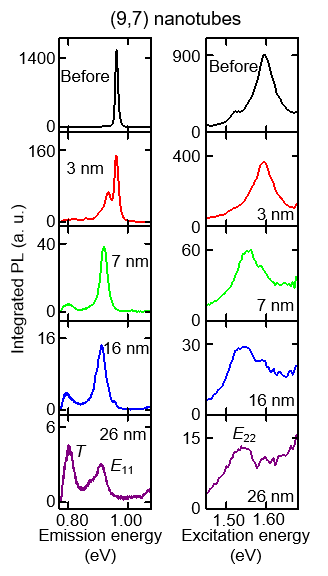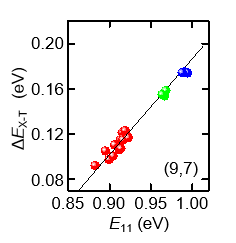Research:Organic molecular tuning of many-body interaction energies in air-suspended carbon nanotubes
The next generation nanotechnology would likely rely on assembly of atomically-defined building blocks such as chirality-identified carbon nanotubes and single organic molecules, enabling molecular-size photovoltaics and photodetectors. Organic molecules such as porphyrin and phthalocyanine couple to nanotubes through π-π interactions to modify the charge density of CNTs, while the emission energy is reduced due to the molecular screening. Furthermore, there are unique exciton dynamics at the organic molecule/CNT interface including exciton and charge transfer. Such a functionalization has been performed mainly for nanotubes in solutions, where the existence of solvent molecules inevitably complicate the interpretation by influencing the interactions. In this work, we investigate adsorption effects of copper phthalocyanine (CuPc) molecules on many-body interactions in air-suspended carbon nanotubes.
Four samples with different deposition amounts are prepared by changing the evaporation time,and we have measured the photoluminesence (PL) and PL excitation (PLE) spectra for the samples. As the deposition amount increases, both the E11 and E22 resonances redshift and the intensities decrease. In addition, a new emission peak is observed at an energy below the E11 peak, which is attributed to trion emission.

Furthermore, data from individual tubes reveal a good correlation between exciton-trion energy separation ΔEX-Tand the E11 energy, suggesting the existence of a universal relationship. We consider a model assuming power law scaling of the interaction energies with dielectric constant to explain the observed correlation.

To learn more about this work, please refer to:
Organic molecular tuning of many-body interaction
energies in air-suspended carbon nanotubes
J. Phys. Chem. C
123, 5776 (2019).
![]()